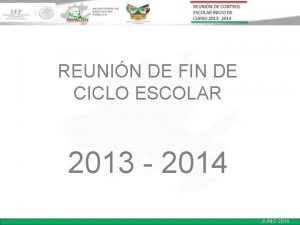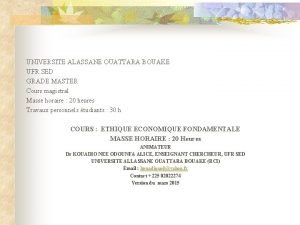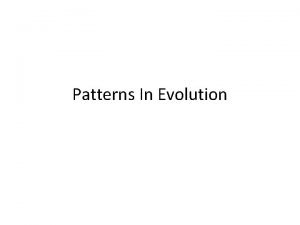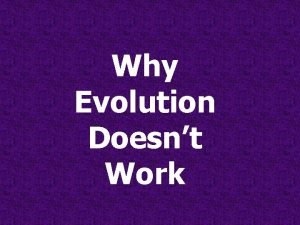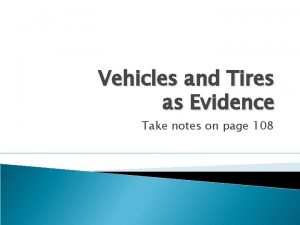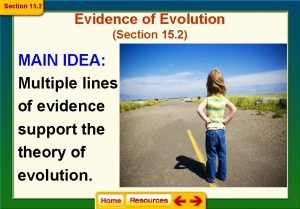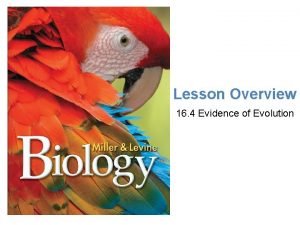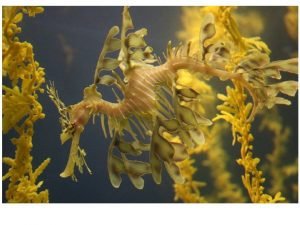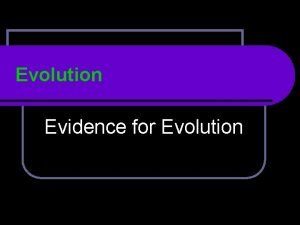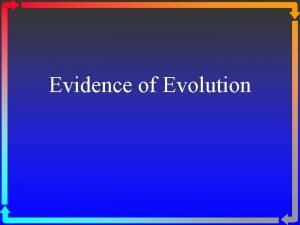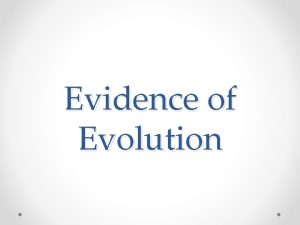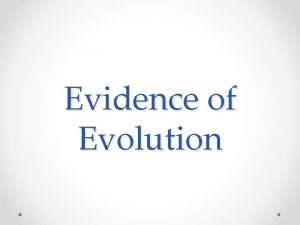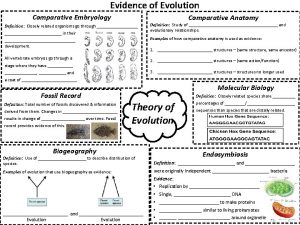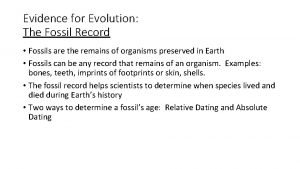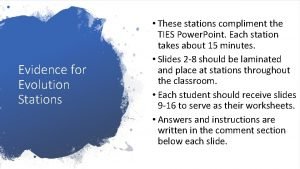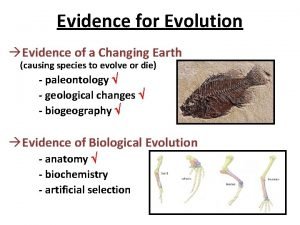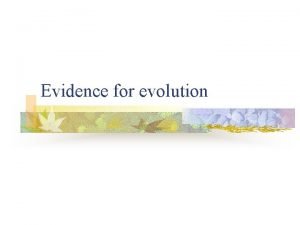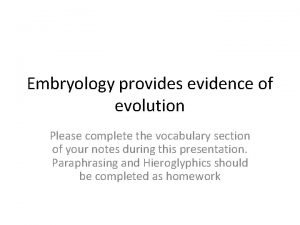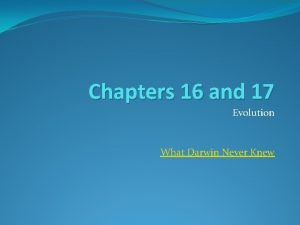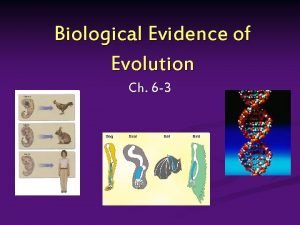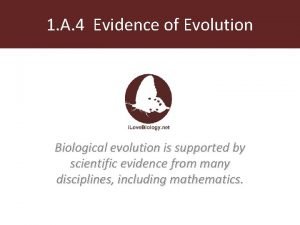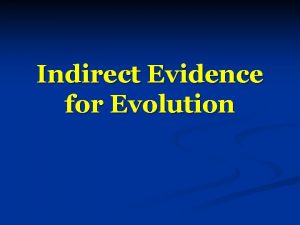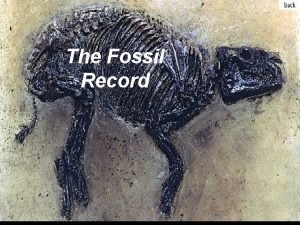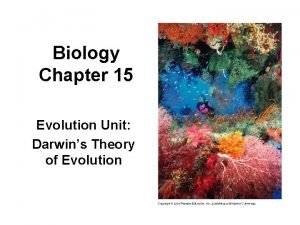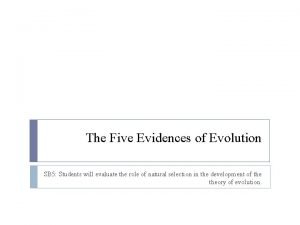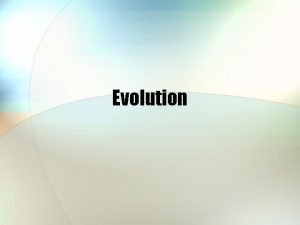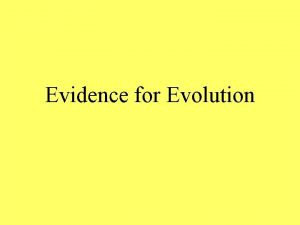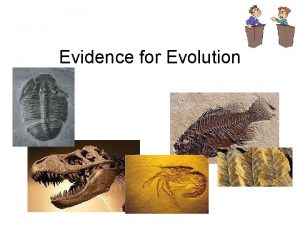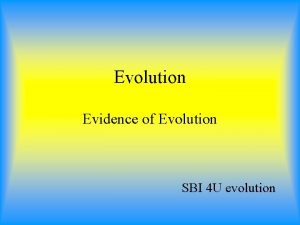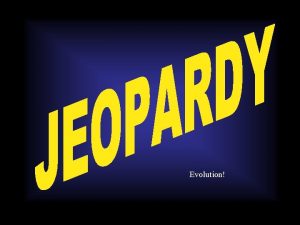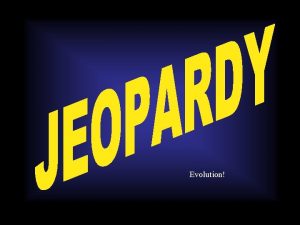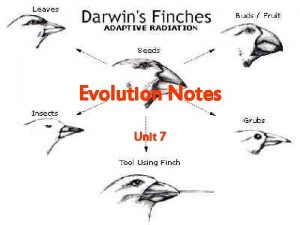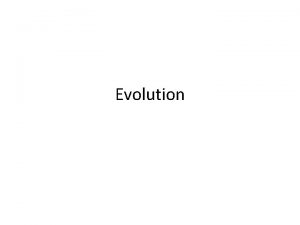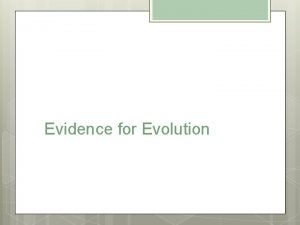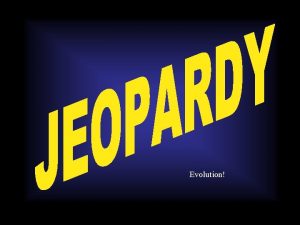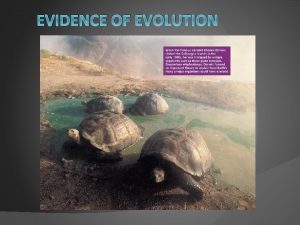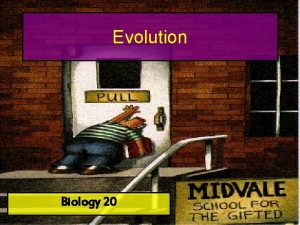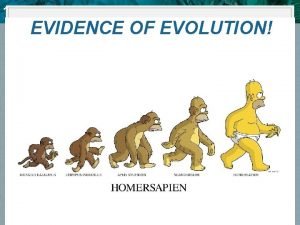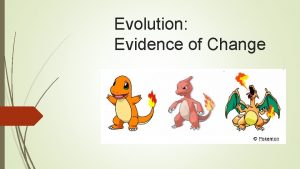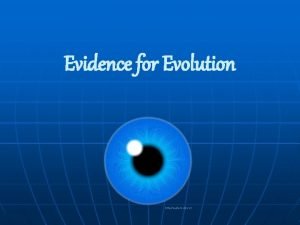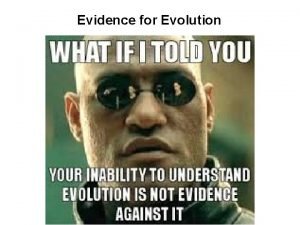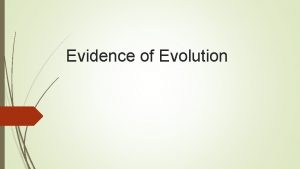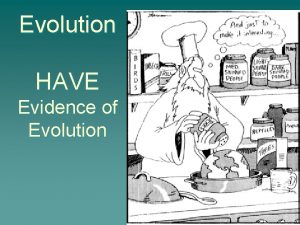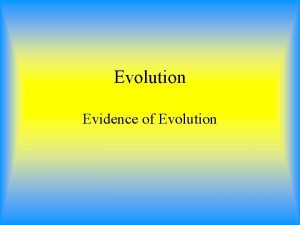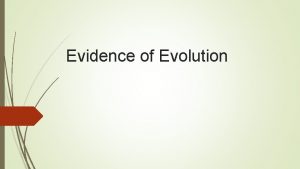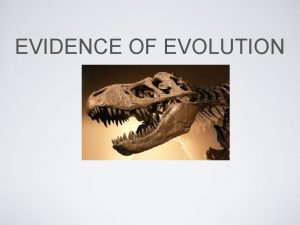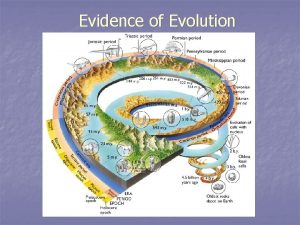Evidence for Evolution 2018 2019 Major Evidence for

















































- Slides: 49

Evidence for Evolution 2018 -2019

Major Evidence for Evolution 1. 2. 3. 4. 5. 6. 7. Fossil record ✔ Morphology ✔ Homologous structures Analogous structures Vestigial structures Embryological development Biochemical evidence--DNA

1. Fossil Record n What does the Fossil Record tell us about organisms? n n n ✔ Looks (size, shape, etc. ) Where or how they lived? What other organisms they lived at that time?

n n n What time period they lived in (based on location in rock layers) What order living things came in (based on location in rock layers) Transitional forms n Organisms that were intermediate (between) two other major organisms ✔

Major Evidence for Evolution 1. Fossil record ✔ 2. 3. 4. 5. 6. 7. Morphology ✔ Homologous structures Analogous structures Vestigial structures Embryological development Biochemical evidence--DNA

2. Morphology In the fossil lab, we will study the morphology of the genus, Adventurian. We look at how the structures evolved over millions of years.

Answer: • The skulls all have similar ridge that protrudes from the top. • The overall shape is the same. Example: Horse • Each skull has a set of flattened teeth. • Each skull has a large diastema, or gap between the front and back teeth. Give at least two similarities between the skulls that might lead to the conclusion that these are all related species.

Answer: The size of the skull is dramatically larger in the modern horse. Example: Horse What is the biggest change in skull anatomy that occurred from the dawn horse to the modern horse?

What is the biggest change in leg anatomy that occurred from the dawn horse to the modern horse? Answer: The modern horse • has much longer legs (started about the size of a dog) • has developed hooves in place of hand/foot bones (changed from 4 toes, to 3 toes to 1 hoof)

Located in New York, New York

Major Evidence for Evolution 1. Fossil record ✔ 2. 3. 4. 5. 6. 7. Morphology ✔ Homologous structures Analogous structures Vestigial structures Embryological development Biochemical evidence--DNA

3. Homologous Structures are bodily structures, in organisms that share a common ancestor, that are similar in structure, but different in function.

Focus on Human Arm


Homologous Structures



Major Evidence for Evolution 1. Fossil record ✔ 2. 3. 4. 5. 6. 7. Morphology ✔ Homologous structures ✔ Vestigial structures Analogous structures Embryological development Biochemical evidence--DNA

4. Vestigial Structures Vestigial structures are structures that serve no function in the present organism, BUT were useful structures in earlier ancestors n human ear muscles n human tailbone n human appendix

Features present in modern animals that are no longer in use. Vestigial structures give hints as to the evolution of organisms. Can include neurological pathways, structures and organs. whale pelvis appendix tailbone

https: //www. youtube. co m/watch? v=9 Vyrb. G 7 FZ 2 Q

What evidence do we have that organisms change over time? n Vestigial Parts https: //www. youtube. com/watch? v=r. Fxu 7 NEo. KC 8



Vestigial Organs Login Instructions

Major Evidence for Evolution 1. Fossil record ✔ 2. 3. 4. 5. 6. 7. Morphology ✔ Homologous structures ✔ Vestigial structures✔ Analogous structures Embryological development Biochemical evidence--DNA

5. Analogous Structures Analogous structures are bodily structures that are similar in function, but not in structure. NOT EVIDENCE OF COMMON ANCESTRY Example: The wings of a bee and wings of a bird didn’t evolve from a common ancestor even though they are both used for flight.


https: //youtu. be/2 N 3 OPRod. Rvk

Major Evidence for Evolution 1. Fossil record ✔ 2. 3. 4. 5. 6. 7. Morphology ✔ Homologous structures ✔ Vestigial structures✔ Analogous structures ✔ Embryological development Biochemical evidence--DNA

6. Embryological Development n Embryo- fertilized egg that will/is in the process of growing into a new individual Login Instructions n Closely related organisms go through similar developmental stages early in development n All vertebrates have gill pouches sometime during their early development


Explorer Learning- Embryo Development 1. Go to www. explorelearning. com 2. Click on “Enroll in a Class” button in the upper right hand corner of the web page. 3. Type in your class code ________. 4. Click continue and follow the directions on the site to complete the enrollment. 5. Make your username your last name and first initial. For example, Elizabeth Megonigal = megonigale 6. Password- make it your birthday (the same as CCPS (mmddyear))

Major Evidence for Evolution 1. Fossil record ✔ 2. 3. 4. 5. 6. 7. Morphology ✔ Homologous structures ✔ Vestigial structures✔ Analogous structures ✔ Embryological development ✔ Biochemical evidence--DNA

7. DNA/Biochemical Evidence DNA contains the instructions needed for an organism to develop, survive and reproduce. To carry out these functions, DNA sequences must be converted into messages that can be used to produce proteins. Proteins are the complex molecules that do most of the work in our bodies.

o The DNA that is used to translate nucleotide sequences into proteins (amino acids) is essentially the same in all organisms. o Proteins in all organisms are composed of the same set of 20 amino acids arranged in various sequences. Powerful argument in favor of the common descent of the most diverse organisms. o

DNA/Biochemical Evidence Cytochrome C n An ancient protein common to all aerobic (oxygen breathing) organisms and is found in the mitochondria. n It is used in studying evolutionary relationships because most animals have this protein. n Cytochrome C is made of 104 amino acids joined together to make an “amino acid sequence”. n Organisms closely related have very similar cytochrome c amino acid sequences. n The more distantly related the organisms are, the greater the difference in the cytochrome c sequence

Major Evidence for Evolution 1. Fossil record ✔ ✔ 2. 3. 4. 5. 6. 7. Morphology ✔ Homologous structures ✔ Vestigial structures✔ Analogous structures ✔ Embryological development ✔ Biochemical evidence—DNA ✔

Looking at all the evidence with the Whale Evolution Kit. What is theory of evolution? -is the process by which organisms change over time as a result of changes in heritable physical or behavioral traits.

Scientists behind the Theory of Evolution 1. 2. 3. Charles Darwin Alfred Wallace Jean Lamarck (only partly correct)

1. Charles Darwin n 1859 – “Origin of Species” published 1. 2. n n Argued from evidence that species inhabiting Earth today descended from ancestral species Proposed a mechanism for evolution Natural Selection Many scientists helped pave the way for Darwin’s Theory www. brainpop. com/science/famou sscientists/charlesdarwin/



Theory of Evolution By Natural Selection In each generation of a species, individuals have slight differences. n Sometimes these variations make an individual more successful in its environment n

(more food, live longer, reproduce more, attract better mates). Then individual may then reproduce and pass this variation on to its offspring. n Then the individual may reproduce and pass this variation on to its offspring. n

Natural Selection n Variations in individuals are controlled by genes. n Individuals have no control over what variations they will have.

n Useful variations are NOT ALWAYS passed on. n Variations that are not useful may also be passed on.

2. Alfred Russel Wallace n co-discovered natural selection and prompted Darwin to finally rush his Origin of Species to press. n One of the modern world’s greatest scientific adventurer explorers n eight-year exploration of Southeast Asia and the Malay Archipelago he wrote The Malay Archipelago in 1869, n Geographical Distribution of Animals (1876) is one of the seminal works in the field. n the workhorse of Darwinian evolution, diverged from Darwin’s methodological naturalism (i. e. , the notion that scientists must invoke only natural processes functioning via unbroken natural laws in nonteleological ways) to propose a theory of evolution defined by intelligence and design.

3. Jean Lamarck WRONG!
 B a f c j e
B a f c j e Conest hidalgo
Conest hidalgo Master sed
Master sed What are the two major patterns of evolution?
What are the two major patterns of evolution? Evidence of evolution
Evidence of evolution Evidence for evolution doodle notes
Evidence for evolution doodle notes Section 15-2 evidence of evolution
Section 15-2 evidence of evolution Evidence for evolution
Evidence for evolution Bottleneck effect
Bottleneck effect Evidence of evolution
Evidence of evolution 4 types of evidence for evolution
4 types of evidence for evolution What is the evidence for evolution
What is the evidence for evolution What are the 4 types of evidence?
What are the 4 types of evidence? Definition of comparative embryology
Definition of comparative embryology What does amber
What does amber Evidence of evolution stations
Evidence of evolution stations Lamarck's theory
Lamarck's theory Embryology evidence of evolution
Embryology evidence of evolution Embryology evidence of evolution examples
Embryology evidence of evolution examples Molecular biology evidence of evolution
Molecular biology evidence of evolution Biological evidence of evolution
Biological evidence of evolution Evidence of evolution
Evidence of evolution Fish tail bird
Fish tail bird Indirect evidence of evolution
Indirect evidence of evolution Evidence of evolution of remnants and impressions *
Evidence of evolution of remnants and impressions * Molecular biology evidence of evolution
Molecular biology evidence of evolution The five evidences of evolution
The five evidences of evolution Embryological evidence of evolution
Embryological evidence of evolution What is primary sources
What is primary sources Primary evidence vs secondary evidence
Primary evidence vs secondary evidence Secondary sources
Secondary sources Primary evidence vs secondary evidence
Primary evidence vs secondary evidence Jobs vancouver
Jobs vancouver Are fibers class evidence
Are fibers class evidence Class vs individual evidence
Class vs individual evidence How can class evidence have probative value
How can class evidence have probative value Class evidence vs individual evidence
Class evidence vs individual evidence Ecological fallacy meaning
Ecological fallacy meaning Iso 22301 utbildning
Iso 22301 utbildning Typiska novell drag
Typiska novell drag Tack för att ni lyssnade bild
Tack för att ni lyssnade bild Returpilarna
Returpilarna Varför kallas perioden 1918-1939 för mellankrigstiden
Varför kallas perioden 1918-1939 för mellankrigstiden En lathund för arbete med kontinuitetshantering
En lathund för arbete med kontinuitetshantering Underlag för särskild löneskatt på pensionskostnader
Underlag för särskild löneskatt på pensionskostnader Tidbok
Tidbok A gastrica
A gastrica Densitet vatten
Densitet vatten Datorkunskap för nybörjare
Datorkunskap för nybörjare Tack för att ni lyssnade bild
Tack för att ni lyssnade bild

